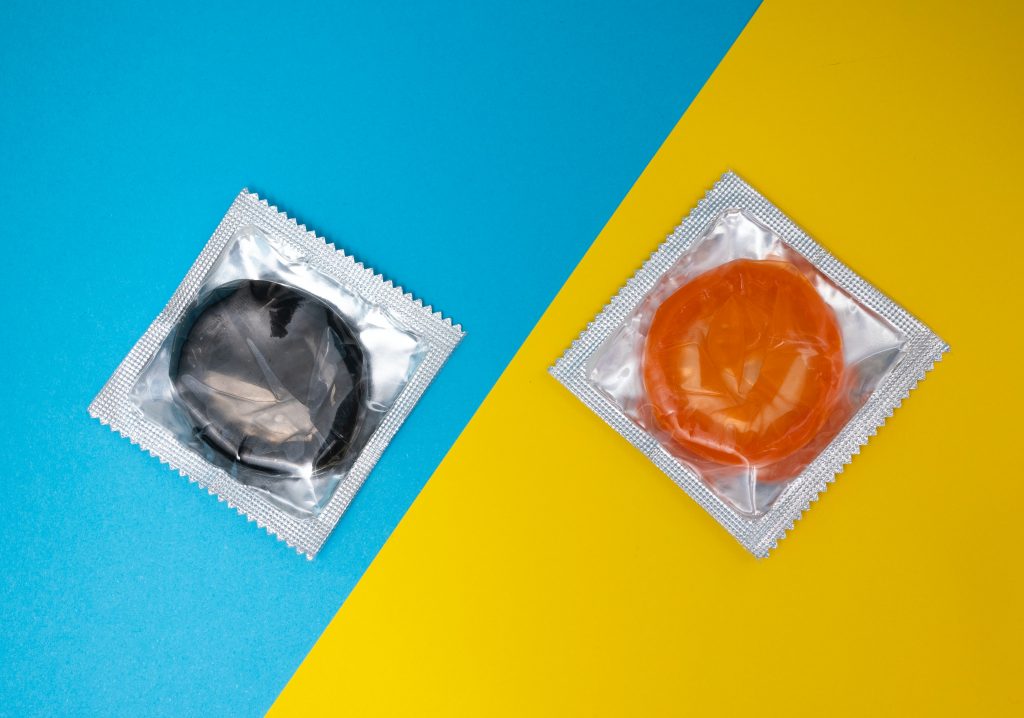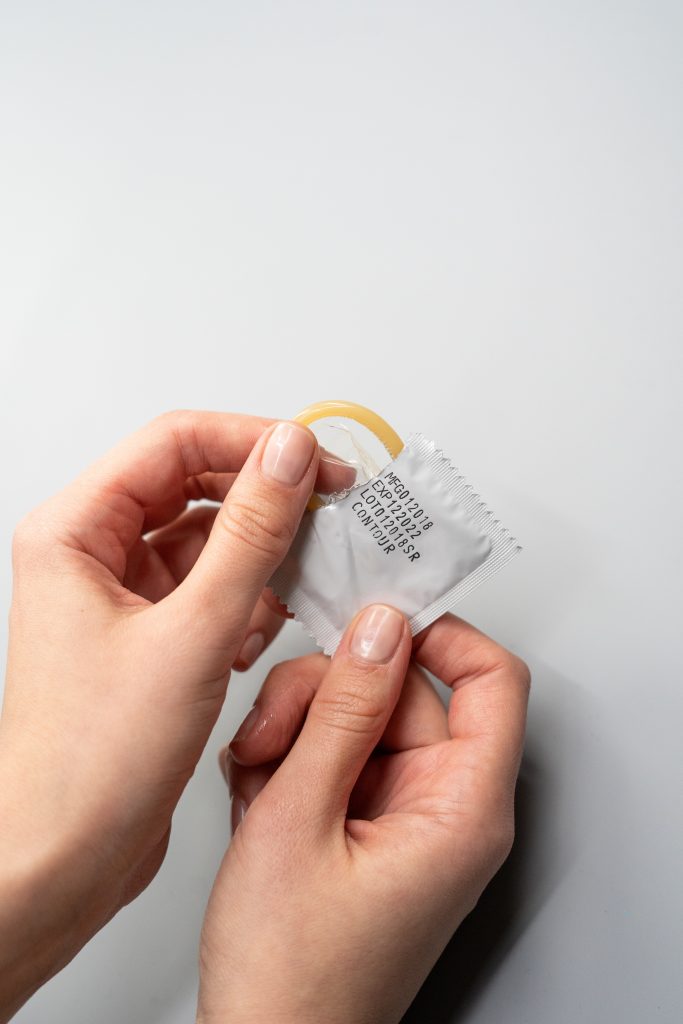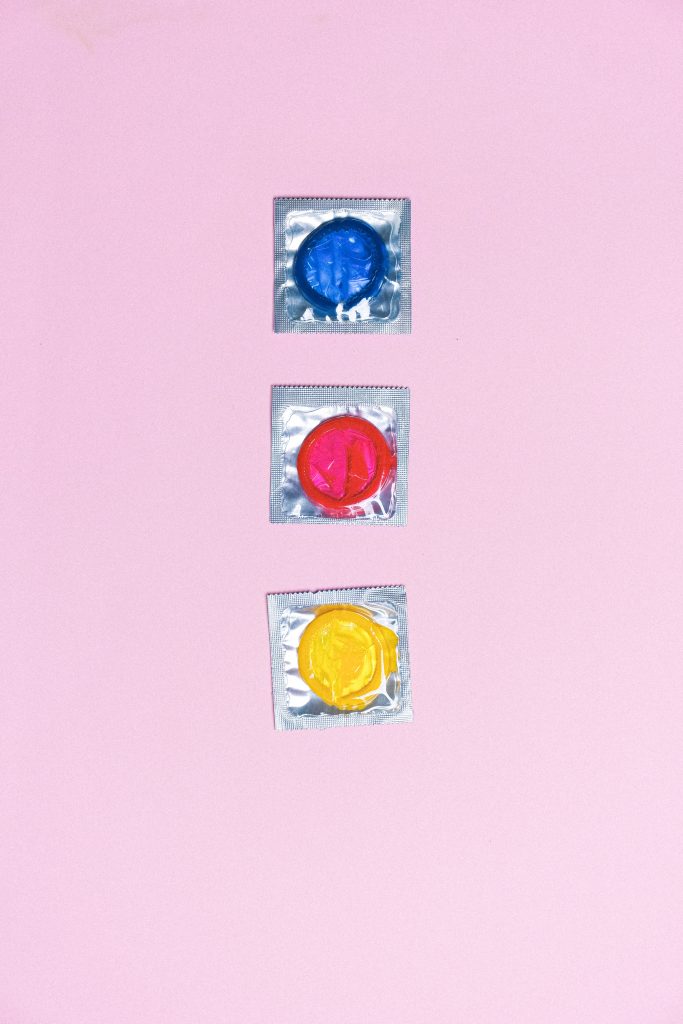
External condoms are a barrier method of contraception used to prevent unwanted pregnancies and the spread of sexually transmitted infections (STIs). An external condom is a thin sheath that is placed over the user’s erect penis before sexual activity. This barrier protects against the spread of STIs by preventing direct contact between the penis and the partner’s skin, mucosa, and genital secretions. The external condom also protects against unwanted pregnancies by blocking sperm from entering the vagina.¹
Condoms may be made of latex, animal skin, or plastic, and can only be used once. A new condom must be used for every separate sex act to avoid breakage and the subsequent leakage of body fluids. During longer sexual encounters, replace the condom every 30 minutes, as it will naturally wear down with prolonged friction. If you switch to a different sex act (such as oral, anal or vaginal) in a single encounter, replace the condom. In group sex, use a different condom each time you switch partners. External condoms must be used consistently and correctly in order to achieve their maximum effectiveness.³
External condoms are sometimes referred to as “male condoms”. In this article, we intentionally avoid this gendered term as it is not inclusive of individuals who may use external condoms and do not identify as male.
Table of Contents
Effectiveness of External Condoms
Condoms are very effective! For perfect users (those who correctly use condoms every time they have sex), the effectiveness rate is 98%. For typical users, the effectiveness rate is approximately 82%.³ The reason typical users have a higher failure rate is largely due to incorrect application or inconsistent usage. We recommend using a condom for every instance of sexual intercourse. Each time, pay special attention to the directions on the condom wrapper, and properly inspect the condom itself.
How To Use An External Condom

Knowledge and experience regarding correct condom application promotes maximum protection. Once the penis is erect, apply the condom prior to any contact with the vagina, anus, or mouth. In order to achieve the maximum protection from pregnancy and STIs, apply the condom correctly and use a new condom for every sexual encounter. Also, never use two condoms at once as this creates additional friction, increasing the likelihood that the condoms will tear.²
How to Check the Quality of a Condom
When using condoms, it is very important to check for any possible damages. This inspection can be done in three simple steps.
Wrapping
First, assess the condom’s wrapping. If the wrapping is worn, torn, or looks old, it is best to dispose of the condom. It is also important to make sure the wrapper is tightly sealed. To ensure the wrapper is tightly sealed, gently press on the packaging and feel for any air leaks. If any air does leak, the condom may be damaged and should be thrown out. Any holes that damaged the wrapper could have damaged the condom itself.²

Expiration Dates
Always check that the condom has not expired. Typically, the expiration date is printed on the back or along the edge of a condom.² If the expiration date is not visible on the condom, or the expiration date has passed, we recommend throwing that condom away and using one that is clearly not expired.
The Condom
After checking that the wrapper is free from any visible damages and the expiration date has not passed, check the actual condom. Additionally, be sure to open the condom properly and carefully. Do not use scissors or any sharp object to open the wrapper; instead, carefully open the condom wrapper by pulling apart the premade notches on one of the corners. Unroll the condom very carefully and check for signs of the “three Ds.”
- Discoloration (a very dark yellow, non-transparent color)
- Damage (any holes, tears, or weak areas on the condom)
- Dryness (is brittle to the touch, sticky, or dry)
If any of these characteristics are present, it is best to dispose of the condom, as each of these factors can contribute to the failure of the condom’s functionality.
Physically Applying the Condom
There are also many factors to keep in mind before physically applying the condom. Failure to be aware of these factors can result in the reduced effectiveness of the condom. These considerations include the following:

- Check the condom (as per the steps written above)
- Ensure that the condom is right-side up so it can properly unroll. The tip of the condom should stick up from the center of the condom so it looks like a small hat.
- Place the tip of the condom on the head of the penis so that it will unroll down the shaft. If the penis is uncircumcised, pull back the foreskin before rolling the condom over the erect penis.
- Pinch and hold the tip of the condom, leaving a reservoir of approximately one inch, as the condom is rolled down the shaft to the base of the penis. The reservoir provides a space to collect the user’s ejaculate. As you roll the condom down, make sure to carefully smooth out any air bubbles along the way.
- Apply water-based or silicone-based lube to the outside of the condom to reduce friction and increase the recipient’s pleasure, especially if the condom is not pre-lubricated.
- HELPFUL HINT – Pull back any pubic hairs that might get in the way of the condom. This step will prevent any unnecessary pain that can negatively affect the enjoyable experience.
- Hold the base of the condom while withdrawing the penis. This step should be done directly after ejaculation and while the penis is still erect to prevent semen spillage.
- Tie the condom in a knot and dispose it into a trashcan. Never flush a condom down the toilet, since it may clog the sewage system and is not biodegradable.
All of these factors contribute to increase the effectiveness of the condom. These factors ensure that the condom’s integrity is consistent throughout the duration of sexual intercourse and that there is no leakage of semen.
Additional Precautions
In order to avoid damages to the condom, specific measures must be taken.
- Avoid moisture, heat, pressure and light as they can make condoms more susceptible to breakage.
- Store condoms in a cool, dry place.
- Avoid keeping condoms in back pockets, wallets, glove compartments, or any other place in which the condom experiences pressure.
Fresh condoms should be used for each sexual encounter. Checking the integrity of the condom prior to use can help protect partners from negative consequences associated with damaged condoms.
Types of Condoms
Latex condoms are the most effective and widely available type of condom.² Latex condoms offer better protection than animal skin condom. For example, lambskin contains pores that are big enough for HIV and other sexually transmittable infections to pass through. Many people prefer animal skin condoms because they are thinner and do not affect sensitivity as much as latex condoms. However, latex condoms offer the best protection against unwanted pregnancy and sexually transmitted infections.² With today’s technology, latex condoms become increasingly thinner, while still providing excellent STI protection. Additionally, there are numerous designs available that serve to enhance both partners’ pleasure (e.g., textured, flavored, warming).
For latex condoms, only use water-based lubricants, such as KY Jelly or Astroglide. Oil-based lubricants damage the condom’s material, therefore compromise its effectiveness. Vaseline, baby oil, and even whipped cream are examples of oil-based lubricants that should not be used¹
Plastic, or polyurethane, condoms are available for individuals that are allergic to latex, which is a type of rubber.⁴ Plastic and latex condoms have similar effectiveness levels. Plastic condoms are slightly thinner, more expensive, and less flexible than latex. Because of these factors, plastic condoms require more lubrication than latex condoms.³
Condoms come in a variety of shapes, widths, and lengths. The style of condom depends on the user’s preference. Latex condoms are made of material intended to stretch and conform to the size of the user’s penis. Still, wearing the appropriate size condom decreases the odds that the condom will slip off or break.
Advantages of the External Condom
The external condom has specific advantages in comparison to other forms of contraception. Some of these advantages relate to cost, effectiveness, accessibility, and reversibility. The advantages of external condoms are as follows:

- When used properly and consistently, the external condom is a very effective method for preventing pregnancy (98% effective with ‘perfect use’) and is one of the few contraceptive methods that can protect against sexually transmitted infections(including HIV and HPV).³
- Condoms are relatively inexpensive.
- Condoms are easy to obtain and can be found at local drugstores, supermarkets, bathroom vending machines, family planning centers (such as Planned Parenthood), or at a healthcare service provider.
- Condoms come in a variety of colors, flavors, scents, textures, and shapes to enhance pleasure for both partners.
- Users do not require a prescription to purchase condoms.
- Condom application can be incorporated into foreplay.
- This type of birth control is immediately reversible if partners decide to conceive.
The external condom offers many advantages over other contraceptive methods. For instance, male condoms are relatively inexpensive and easy to obtain. External condoms are also one of the few contraceptive methods that provide protection against sexually transmitted infections. Additionally, external condoms continue to provide excellent protection against unwanted pregnancies with an effectiveness rate of 98% when used correctly every time.³
Disadvantages of the External Condom
\Although external condoms have some advantages over other contraceptive methods, external condoms also have disadvantages as well. The disadvantages of the external condom are as follows:
- Condom application can interrupt the spontaneity of sex.
- Some condoms can affect the user’s sensitivity.
- Condoms are not 100% effective, but still remain a very reliable method to prevent STIs and unwanted pregnancies.
- The user may feel self-conscious while putting the condom on and may lose their erection. If they feel anxious, they can reduce tension by allowing their partner to roll the condom onto their penis.
- The condom may pinch the penis.
- Condoms can deteriorate with age, especially if kept in hot or sunny places.
Each contraceptive method has its own unique advantages and disadvantages. Therefore, we recommend that you review the advantages and disadvantages of each contraceptive method so that you can decide which method is best suitable for you.
Cost
While a typical condom ranges anywhere from $0.30 to $1.00, it is more cost effective to buy them in bulk. Your local Planned Parenthood or health clinic may provide free or inexpensive condoms. However, ribbed, flavored, glow in the dark, lubricated, and spermicidal condoms are more expensive than regular ones.
Concluding Remarks
Ultimately, the external condom is an excellent form of contraception that can help to prevent unwanted pregnancies and the spread of sexually transmitted infections. It is also a very accessible and affordable form of contraception that is easy to use with proper knowledge and experience. Remember to inspect the quality of the condom before use to ensure that the condom has not been damaged. Condoms also come in a variety of different shapes, sizes, colors, and tastes. For many of these reasons, the external condom remains one of the most widely used forms of contraception in the world.
Check out this video about condoms!
References
- “Condoms.” AVERTing HIV and AIDS. AVERT, 01 May 2015.
- “Male Condom.” Center for Disease Control and Prevention. U.S. Department of Health and Human Services, 17 Aug. 2016.
- “How Effective are Condoms?” Planned Parenthood. Planned Parenthood, 14 Jan. 2016.
- “Male Condoms and STDs.” U S Food and Drug Administration Home Page. Office of the Commissioner, 24 Oct. 2016.
- “How to Put on a Condom -Planned Parenthood” YouTube.
Last Updated: 24 May 2022.
